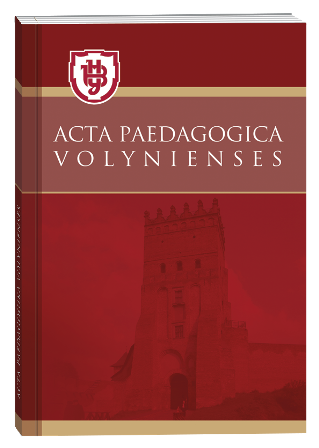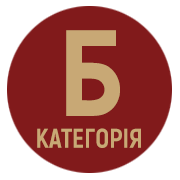PREPARATION OF FUTURE TEACHERS FOR THE USE OF COMPETENT TEACHING METHODS OF RHETORIC IN UKRAINIAN LANGUAGE LESSONS
DOI:
https://doi.org/10.32782/apv/2022.6.16Keywords:
key competence, teaching method, competence teaching of rhetoric, future teachers of Ukrainian language and literature.Abstract
The article raises the problem of training future teachers to use methods of competence-based rhetoric training in Ukrainian language classes. Given the fact that one of the priority tasks of the subject teacher is the formation of a number of cross-cutting skills and key competences in students, among which fluency in the state language occupies a special place, the emphasis is on methods that ensure the formation of a competent speaker. Since the rhetorician is able to successfully resolve issues related to mastering the secrets of effective communication and the laws of oratory, there was a need to include this discipline in the curricula of higher education institutions. However, educational practice convinces that students should learn the theory of rhetoric, skillfully master the language, it is very important to acquire communicative experience, persistently form critical and logical thinking, linguistic creativity, master an effective methodological toolkit, because the teacher should possess a set of methods and techniques for stimulating students to speak improve. It is important to acquaint them with the methods of competence-oriented teaching of rhetoric in Ukrainian language classes. The article emphasizes that the training of future teachers to apply methods of competence-oriented teaching of rhetoric should take place on an interdisciplinary basis. This enables a multi-faceted consideration of the problem of applying rhetoric teaching methods in school practice, which should occur equally in the methodology course and in the process of mastering rhetoric. It is noted that the result of interdisciplinary training can be the students' rhetorical portfolio. The didactic, developmental, and educational potential of the methods of rhetorical competence training are determined, ways of familiarizing language teachers with them, and ideas regarding their use in the educational process are presented. The role and prospects of using competence-based methods of teaching rhetoric are revealed; criteria for their selection and conditions of application are defined and characterized. It has been found that the application of methods of rhetorical competence training contributes to increasing the motivation of male and female students to learn the Ukrainian language, use it in any life situations, and the ability to communicate tolerantly and effectively.
References
Голуб Н.Б. Зошит з риторики. 10 клас. К.: Педагогічна думка. 2018. 63 с.
Голуб Н.Б. Самостійна робота студентів з риторики: Навч. методичний посібник. Черкаси: Брама. 2008. 232 с.
Голуб Н., Горошкіна О. Методи дистанційного навчання української мови. Український педагогічний журнал. 2022. № 4. С. 145–158. URL: https://uej.undip.org.ua/index.php/journal/article/view/635
Голуб Н.Б., Горошкіна О.М. (2022) Українська мова: Підручник для 5 класу. URL: https://lib.imzo.gov.ua/ yelektronn-vers-pdruchnikv/5-klas-nush/movno-lteraturna-galuz/ukranska-mova/ukranska-mova-pdruchnik-dlya-5- klasu-zakladv-zagalno-seredno-osvti-avt-golub-n-b-goroshkna-o-m_1/
Голуб Н.Б., Новосьолова В.І., Галаєвська Л.В. Мовленнєві жанри на уроках української мови в ліцеї (рівень стандарту): практичний посібник. К.: КОНВІ ПРІНТ. 2020. 128 с.
Горобець С.І. Риторична підготовка майбутнього вчителя української мови і літератури як об’єкт теоретичного аналізу в педагогічній практиці на текстовій основі. Науковий часопис Національного педагогічного університету імені МП Драгоманова. Серія 5. Педагогічні науки: реалії та перспективи. 2020. Вип. 78. С. 61–65.
Державний стандарт базової середньої освіти: Постанова Кабінету Міністрів України від 30 вересня 2020 р. № 898. URL: https://zakon.rada.gov.ua/laws/show/898-2020-%D0%BF#n16.
Державний стандарт початкової освіти: Постанова Кабінету Міністрів України від 21.02.2018 р. № 87. URL: http://zakon.rada.gov.ua/laws/show/87-2018-%D0%BF
Кузнецова Г.П., Корчова О.М., Кухарчук І.О., Холявко І.В. Культура мовлення та риторика: навч. посібник. Глухів: Глухівський НПУ ім. О. Довженка. 2020. 324 с.
Нова українська школа: Концептуальні засади реформування середньої школи : МОН України. Київ, 2016. 40 с.
Оклі Б. Навчитися вчитися. Як запустити свій мозок на повну / пер. з англ. А. Замоцний. 3-тє вид. К.: Наш формат. 2020. 272 с. 12. Педагогічна риторика: історія, теорія, практика : монографія / [О.А. Кучерук, Н.Б. Голуб, О.М. Горошкіна, С.О. Караман та ін.] ; за ред. О.А. Кучерук. Київ : КНТ, 2016. 258 с.
Словник-довідник з української лінгводидактики (2015) : навч. посіб./ Кол. авторів за ред. М.І. Пентилюк. Київ : Ленвіт, 2015. 320 с.
Типова освітня програма для закладів загальної середньої освіти : Іншомовна галузь. Іноземна мова (розроблена під керівництвом О.Я. Савченко) : наказ МОН України від 21.03.2018 № 268. URL: https://mon.gov.ua/ua/ osvita/zagalna-serednya-osvita/navchalni-programi/navchalni-programi-dlya-pochatkovoyi-shkoli
Українська мова: Модельна навчальна програма. 5-6 класи для закладів загальної середньої освіти / Голуб Н.Б., Горошкіна О.М. URL: https://drive.google.com/file/d/1ngp-IBriUmeHFzzN-7QxjTU14_c9BRE0/view
Українська мова для загальноосвітніх навчальних закладів з українською мовою навчання. 10–11 класи. Рівень стандарту. 2017. URL: https://mon.gov.ua/ua/osvita/zagalna-serednya-osvita/navchalni-programi/navchalniprogrami- dlya-10-11-klasiv
Українська мова 10–11 класи. Програма для профільного навчання учнів загальноосвітніх навчальних закладів / Л. Мацько, Т. Груба, О. Семеног, Т. Симоненко. Інформаційний збірник та коментарі Міністерства освіти і науки України. 2017. № 12. С. 3–73.







